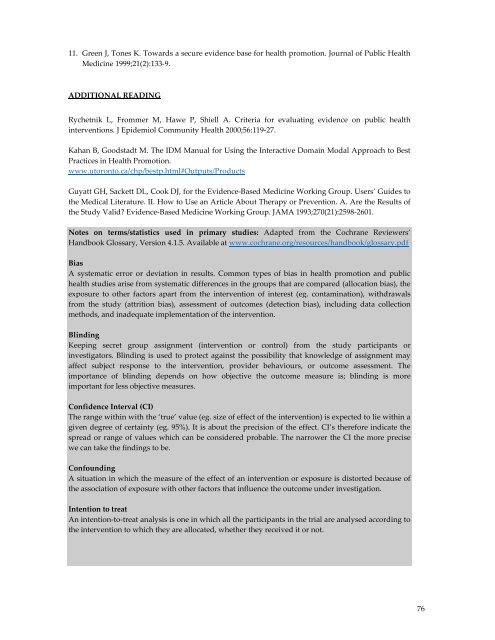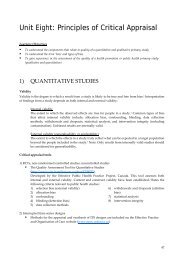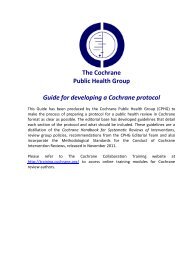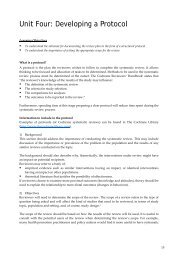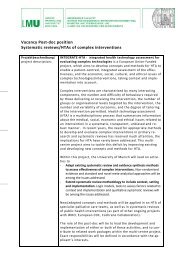Train the Trainer Course book - Cochrane Public Health Group
Train the Trainer Course book - Cochrane Public Health Group
Train the Trainer Course book - Cochrane Public Health Group
You also want an ePaper? Increase the reach of your titles
YUMPU automatically turns print PDFs into web optimized ePapers that Google loves.
11. Green J, Tones K. Towards a secure evidence base for health promotion. Journal of <strong>Public</strong> <strong>Health</strong><br />
Medicine 1999;21(2):133-9.<br />
ADDITIONAL READING<br />
Rychetnik L, Frommer M, Hawe P, Shiell A. Criteria for evaluating evidence on public health<br />
interventions. J Epidemiol Community <strong>Health</strong> 2000;56:119-27.<br />
Kahan B, Goodstadt M. The IDM Manual for Using <strong>the</strong> Interactive Domain Modal Approach to Best<br />
Practices in <strong>Health</strong> Promotion.<br />
www.utoronto.ca/chp/bestp.html#Outputs/Products<br />
Guyatt GH, Sackett DL, Cook DJ, for <strong>the</strong> Evidence-Based Medicine Working <strong>Group</strong>. Users’ Guides to<br />
<strong>the</strong> Medical Literature. II. How to Use an Article About Therapy or Prevention. A. Are <strong>the</strong> Results of<br />
<strong>the</strong> Study Valid? Evidence-Based Medicine Working <strong>Group</strong>. JAMA 1993;270(21):2598-2601.<br />
Notes on terms/statistics used in primary studies: Adapted from <strong>the</strong> <strong>Cochrane</strong> Reviewers’<br />
Hand<strong>book</strong> Glossary, Version 4.1.5. Available at www.cochrane.org/resources/hand<strong>book</strong>/glossary.pdf<br />
Bias<br />
A systematic error or deviation in results. Common types of bias in health promotion and public<br />
health studies arise from systematic differences in <strong>the</strong> groups that are compared (allocation bias), <strong>the</strong><br />
exposure to o<strong>the</strong>r factors apart from <strong>the</strong> intervention of interest (eg. contamination), withdrawals<br />
from <strong>the</strong> study (attrition bias), assessment of outcomes (detection bias), including data collection<br />
methods, and inadequate implementation of <strong>the</strong> intervention.<br />
Blinding<br />
Keeping secret group assignment (intervention or control) from <strong>the</strong> study participants or<br />
investigators. Blinding is used to protect against <strong>the</strong> possibility that knowledge of assignment may<br />
affect subject response to <strong>the</strong> intervention, provider behaviours, or outcome assessment. The<br />
importance of blinding depends on how objective <strong>the</strong> outcome measure is; blinding is more<br />
important for less objective measures.<br />
Confidence Interval (CI)<br />
The range within with <strong>the</strong> ‘true’ value (eg. size of effect of <strong>the</strong> intervention) is expected to lie within a<br />
given degree of certainty (eg. 95%). It is about <strong>the</strong> precision of <strong>the</strong> effect. CI’s <strong>the</strong>refore indicate <strong>the</strong><br />
spread or range of values which can be considered probable. The narrower <strong>the</strong> CI <strong>the</strong> more precise<br />
we can take <strong>the</strong> findings to be.<br />
Confounding<br />
A situation in which <strong>the</strong> measure of <strong>the</strong> effect of an intervention or exposure is distorted because of<br />
<strong>the</strong> association of exposure with o<strong>the</strong>r factors that influence <strong>the</strong> outcome under investigation.<br />
Intention to treat<br />
An intention-to-treat analysis is one in which all <strong>the</strong> participants in <strong>the</strong> trial are analysed according to<br />
<strong>the</strong> intervention to which <strong>the</strong>y are allocated, whe<strong>the</strong>r <strong>the</strong>y received it or not.<br />
76


